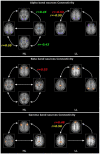Dynamic networks differentiate the language ability of children with cochlear implants
- PMID: 37409105
- PMCID: PMC10318154
- DOI: 10.3389/fnins.2023.1141886
Dynamic networks differentiate the language ability of children with cochlear implants
Abstract
Background: Cochlear implantation (CI) in prelingually deafened children has been shown to be an effective intervention for developing language and reading skill. However, there is a substantial proportion of the children receiving CI who struggle with language and reading. The current study-one of the first to implement electrical source imaging in CI population was designed to identify the neural underpinnings in two groups of CI children with good and poor language and reading skill.
Methods: Data using high density electroencephalography (EEG) under a resting state condition was obtained from 75 children, 50 with CIs having good (HL) or poor language skills (LL) and 25 normal hearing (NH) children. We identified coherent sources using dynamic imaging of coherent sources (DICS) and their effective connectivity computing time-frequency causality estimation based on temporal partial directed coherence (TPDC) in the two CI groups compared to a cohort of age and gender matched NH children.
Findings: Sources with higher coherence amplitude were observed in three frequency bands (alpha, beta and gamma) for the CI groups when compared to normal hearing children. The two groups of CI children with good (HL) and poor (LL) language ability exhibited not only different cortical and subcortical source profiles but also distinct effective connectivity between them. Additionally, a support vector machine (SVM) algorithm using these sources and their connectivity patterns for each CI group across the three frequency bands was able to predict the language and reading scores with high accuracy.
Interpretation: Increased coherence in the CI groups suggest overall that the oscillatory activity in some brain areas become more strongly coupled compared to the NH group. Moreover, the different sources and their connectivity patterns and their association to language and reading skill in both groups, suggest a compensatory adaptation that either facilitated or impeded language and reading development. The neural differences in the two groups of CI children may reflect potential biomarkers for predicting outcome success in CI children.
Keywords: age of intervention; cochlear implant; electrical source imaging (ESI); electroencephalography (EEG); language and reading.
Copyright © 2023 Koirala, Deroche, Wolfe, Neumann, Bien, Doan, Goldbeck, Muthuraman and Gracco.
Conflict of interest statement
The authors declare that the research was conducted in the absence of any commercial or financial relationships that could be construed as a potential conflict of interest.
Figures






Similar articles
-
Links of Prosodic Stress Perception and Musical Activities to Language Skills of Children With Cochlear Implants and Normal Hearing.Ear Hear. 2020 Mar/Apr;41(2):395-410. doi: 10.1097/AUD.0000000000000763. Ear Hear. 2020. PMID: 31397704
-
Long-term language levels and reading skills in mandarin-speaking prelingually deaf children with cochlear implants.Audiol Neurootol. 2011;16(6):359-80. doi: 10.1159/000322310. Epub 2010 Dec 30. Audiol Neurootol. 2011. PMID: 21196727
-
Speech, language, and reading skills after early cochlear implantation.Arch Otolaryngol Head Neck Surg. 2004 May;130(5):634-8. doi: 10.1001/archotol.130.5.634. Arch Otolaryngol Head Neck Surg. 2004. PMID: 15148189
-
Spoken Language Skills in Children With Bilateral Hearing Aids or Bilateral Cochlear Implants at the Age of Three Years.Ear Hear. 2022 Jan/Feb;43(1):220-233. doi: 10.1097/AUD.0000000000001092. Ear Hear. 2022. PMID: 34260435 Free PMC article.
-
Paediatric cochlear implantation: prosthetic hearing and language development.Lancet. 2002 Aug 10;360(9331):483-5. doi: 10.1016/S0140-6736(02)09679-4. Lancet. 2002. PMID: 12241737 Review.
Cited by
-
Characterization of Cochlear Implant Artifact and Removal Based on Multi-Channel Wiener Filter in Unilateral Child Patients.Bioengineering (Basel). 2024 Jul 24;11(8):753. doi: 10.3390/bioengineering11080753. Bioengineering (Basel). 2024. PMID: 39199711 Free PMC article.
-
Cross-modal plasticity in children with cochlear implant: converging evidence from EEG and functional near-infrared spectroscopy.Brain Commun. 2024 May 21;6(3):fcae175. doi: 10.1093/braincomms/fcae175. eCollection 2024. Brain Commun. 2024. PMID: 38846536 Free PMC article.
-
Motor Processing in Children With Cochlear Implants as Assessed by Functional Near-Infrared Spectroscopy.Percept Mot Skills. 2024 Feb;131(1):74-105. doi: 10.1177/00315125231213167. Epub 2023 Nov 17. Percept Mot Skills. 2024. PMID: 37977135 Free PMC article.
-
The neural characteristics influencing literacy outcome in children with cochlear implants.Brain Commun. 2025 Feb 21;7(2):fcaf086. doi: 10.1093/braincomms/fcaf086. eCollection 2025. Brain Commun. 2025. PMID: 40046341 Free PMC article.
References
-
- Amjad A. M., Halliday D. M., Rosenberg J. R., Conway B. A. (1997). An extended difference of coherence test for comparing and combining several independent coherence estimates: theory and application to the study of motor units and physiological tremor. J. Neurosci. Methods 73 69–79. 10.1016/S0165-0270(96)02214-5 - DOI - PubMed
-
- Arnold N., Tapio S. (2001). Estimation of parameters and eigenmodes of multivariate autoregressive models. ACM Trans. Math. Softw. 27, 27–57. 10.1145/382043.382304 - DOI
Grants and funding
LinkOut - more resources
Full Text Sources

